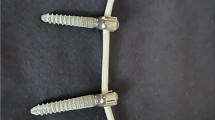Abstract
“V” shaped widening of the predens space (PDS) in flexion can be a worrisome finding in trauma patients, possibly representing injury to the transverse ligament. These patients may also show widening of the C-1/C-2 interspinous distance. We think this appearance is usually due to increased flexion mobility at the atlantoaxial level with developmental elongation or laxity of the cranial end of the transverse ligament and/or the posterior ligamentous complex. Tearing of only the cranial end of the transverse ligament must be extremely rare, if it occurs at all; there is no reported proven case. Tearing of only posterior ligaments seems possible and should be evaluated clinically.
Similar content being viewed by others
References
Althoff B, Goldie IF (1981) Causes of atlanto-axial dislocation and the strength of posterior fixation. Arch Orthop Trauma Surg 98:79
Coults MB (1934) Atlanto-epistropheal subluxations. Arch Surg 29:297
Daniels DL, Williams AL, Haughton VM (1983) Computed tomography of the articulations and ligaments of the occipito-atlantoaxial region. Radiology 146:709
Englander O (1942) Non-traumatic occipito-atlanto-axial dislocation. A contribution to the radiology of the atlas. Br J Radiol 15:341
Fielding JW, Van Cochran GB, Lawsing JF III, Hohl M (1974) Tears of the transverse ligament of the atlas. J Bone Joint Surg [Am] 56:1683
Gehweiler JA Jr, Duff DE, Martinez S, Miller MD, Clark WM (1976) Fractures of the atlas vertebra. Skeletal Radiol 1:97
Greenberg AD (1968) Atlanto-axial dislocations. Brain 91:655
Hanafee W, Crandall P (1966) Trauma of the spine and its contents. Radiol Clin North Am 4:365
Jackson H (1983) Atlantoaxial subluxation. Radiology (letter to the editor) 148:864
Krantz P (1980–81) Isolated disruption of the transverse ligament of the atlas: an injury easily overlooked at postmortem examination. Injury 12:168
Pennecot GF, Gouraud D, Hardy JR, Pouliquen JC (1984) Roentgenographical study of the stability of the cervical spine in children. J Pediatr Orthop 4:346
Penning L (1978) Normal movements of the cervical spine. AJR 130:317
Shapiro R, Youngberg AS, Rothman SLG (1973) The differential diagnosis of traumatic lesions of the occipital-atlanto-axial segment. Radiol Clin North Am 11: 505
Spence KF Jr, Decker S, Sell KW (1970) Bursting atlantal fracture associated with rupture of the transverse ligament. J Bone Joint Surg [Am] 52:543
Swischuk LE, Hayden CK Jr, Sarwar M (1979) The posteriorly tilted dens. A normal variation mimicking a fractured dens. Pediatr Radiol 8:27
Wackenheim A (1974) Roentgen diagnosis of the craniovertebral region. Springer, New York, p 267
Werne S (1957) Studies in spontaneous atlas dislocation. Acta Orthop Scand Suppl 23
Wollin DG, Botterell EH (1958) Symmetrical forward luxation of the atlas. AJR 79:575
Author information
Authors and Affiliations
Rights and permissions
About this article
Cite this article
Bohrer, S.P., Klein, A. & Martin, W. “V” shaped predens space. Skeletal Radiol 14, 111–116 (1985). https://doi.org/10.1007/BF00349745
Issue Date:
DOI: https://doi.org/10.1007/BF00349745




